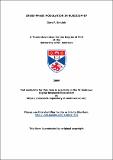Files in this item
Cross-phase modulation in rubidium-87
Item metadata
| dc.contributor.advisor | Korolkova, Natalia | |
| dc.contributor.author | Sinclair, Gary F. | |
| dc.coverage.spatial | 127 | en |
| dc.date.accessioned | 2009-08-13T15:57:26Z | |
| dc.date.available | 2009-08-13T15:57:26Z | |
| dc.date.issued | 2009-06-26 | |
| dc.identifier.uri | https://hdl.handle.net/10023/735 | |
| dc.description.abstract | This thesis explores the theoretical foundations of cross-phase modulation (XPM) between optical fields in the N-configuration atom. This is the process by which the refractive index experienced by one field can be modulated by controlling the intensity of another. The electro-optical version of this effect was first discovered by John Kerr in 1875 and found applications in photonics as a means of very rapidly modulating the phase and intensity of electromagnetic fields. Due to recent advances in experimental techniques there has been growing interest in generating nonlinear optical interactions in coherently prepared atomic ensembles. The use of coherently prepared media brings the possibility of achieving a much larger cross-phase modulation than is possible using classical materials. This is particularly useful when trying to create large optical nonlinearities between low-intensity electromagnetic fields. Much of the current research into cross-phase modulation is directed towards realising potential applications in the emerging field of quantum information processing. Above all, the possibility of constructing an all-optical quantum computer has been at the heart of much research and controversy in the field. In this thesis the theory of steady-state, transient and pulsed cross-phase modulation is developed. Moreover, care has been taken to relate all research back to experimentally feasible situations. As such, the relevance of the theory is justified by consideration of the situation present in rubidium-87. Due to the close relationship between XPM in the N-configuration atom and electromagnetically induced transparency in the Lambda-atom, many similarities and insights act as link between these two fields. Indeed, it is frequently demonstrated that the key to understanding the various properties of XPM in the N-configuration atom is by comparison with the situation in the corresponding Lambda-atom equivalent. | en |
| dc.format.extent | 1079460 bytes | |
| dc.format.mimetype | application/pdf | |
| dc.language.iso | en | en |
| dc.publisher | University of St Andrews | |
| dc.subject | Electromagnetically induced transparency | en |
| dc.subject | EIT | en |
| dc.subject | Cross phase modulation | en |
| dc.subject | XPM | en |
| dc.subject | Kerr effect | en |
| dc.subject | Rubidium | en |
| dc.title | Cross-phase modulation in rubidium-87 | en |
| dc.type | Thesis | en |
| dc.type.qualificationlevel | Doctoral | en |
| dc.type.qualificationname | PhD Doctor of Philosophy | en |
| dc.publisher.institution | The University of St Andrews | en |
This item appears in the following Collection(s)
Items in the St Andrews Research Repository are protected by copyright, with all rights reserved, unless otherwise indicated.

